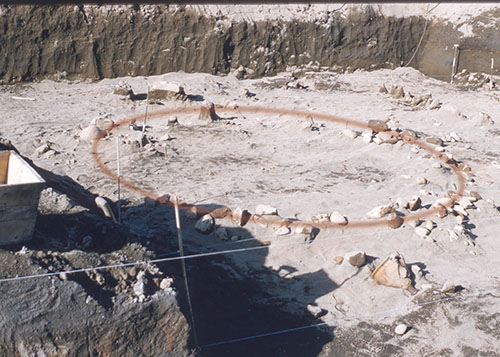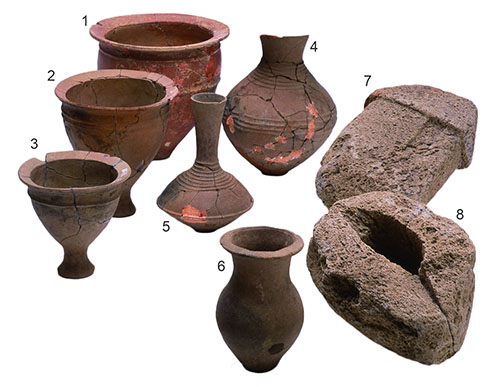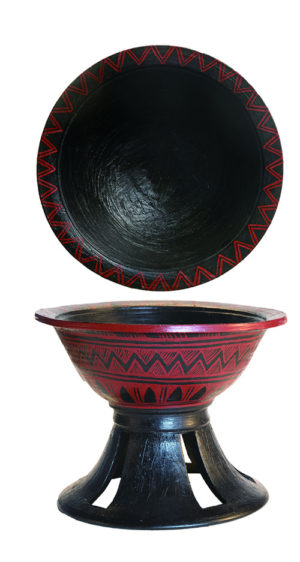Kinkō Town, Kagoshima Prefecture
Middle Yayoi, latter half (approximately 2,100 years ago)

Circular stone arrangement This is the largest stone feature found in the excavations. It utilizes pieces of pumice arranged in a circle with an internal diameter of 3 m. Cooking pots and jars were placed around the circumference, and charcoal concentrations thought to be traces of campfires were ascertained at seven locations.
Stone figurines Made from pumice. At right is a male with perforations in both ears as if wearing disc-shaped earrings. The height is 35.8 cm. At left is a female with her hair tied up in two bunches, and shaped with breasts. The height is 26.4 cm.

Stone arrangements detected in the No. 3 excavation A standing stone 73 cm tall and in the shape of a square pillar is placed nearby circular stone arrangements. As the lower end of the standing stone was unweathered, it is thought to have been partly buried in the ground at the time of placement. Adapted from Hakkutsu sareta Nihon rettō 2019 [Excavations in the Japanese Archipelago, 2019] (Bunkachō [Agency for Cultural Affairs], ed., Kyodo News, 2019).
Jug-shaped vessel Painted vermilion and with a handle. A form seen here and there in the Buzen region (eastern Fukuoka and northern Ōita Prefectures), it is an imported item. Height: 21.4 cm.
Distant view of the site at the time of excavation Located in a coastal sand dune area facing Kagoshima Bay (also called Kinkō Bay locally). The arrow indicates the site of excavation No. 1 (1958–59). Adapted from Hakkutsu sareta Nihon rettō 2019 [Excavations in the Japanese Archipelago, 2019] (Bunkachō [Agency for Cultural Affairs], ed., Kyodo News, 2019).
Recovered artifacts Item 1 is a vermilion-painted pot made in the manner of the Sugu style, and brought from the central Kyushu region. The remaining pottery items are of the Yamanokuchi style. Items 1–3 are cooking pots, with heights of 31.9 cm, 28.3 cm, and 28.1 cm, respectively. Items 4 and 6 are jars, 37.1 cm and 24.5 cm in height, respectively. Item 5 is a long-necked jar, 29 cm in height. Item 7 is a (house-shaped?) object fashioned from pumice, 39.9 cm in height. Item 8 is a pumice-made object (shaped as a Yin stone, female genitalia) 35 cm long.
Pedestaled bowl reconstruction
Pedestaled bowl In lower strata 2 m beneath pottery of the latter half of the Middle Yayoi period, an assemblage of pottery from the start to the initial portion of the Middle Yayoi (approximately 2,300 years ago) was recovered. One of those items was a pedestaled bowl with the entire vessel painted in black, and a sawtooth pattern drawn in red on the outer surface. The conditions of discovery in 1958 are recorded in the well of the bowl.
The late Kawaguchi Sadanori While teaching high school starting from the late 1940s on the one hand, he also conducted academic excavations within Kagoshima Prefecture, striving to protect cultural properties. In the excavations at the Yamanokuchi site, in addition to members of the archaeology club from the high school where Kawaguchi taught, local middle and high school volunteers also participated.
A Yayoi period ritual site surviving in a sand dune
Circular stone arrangements accompanied by standing stones
Located on the southern part of the Ōsumi peninsula, the Yamanokuchi site is formed on a coastal sand dune area facing Kinkō (Kagoshima) Bay with the Kimotsuki mountains bearing down closely at its back.
In 1958, as large amounts of Yayoi pottery along with stone figurines and other items fashioned of pumice were uncovered while quarrying for iron sand, between that year and 1961 excavations were carried out in which Kawaguchi Sadanori, serving as a cultural properties expert for Kagoshima Prefecture at the time, was the central figure. Kawaguchi’s collected materials were donated in their entirety to the prefecture after he passed away in 2011, and as part of a project to organize and utilize this “Kawaguchi Collection,” a reexamination of materials on the Yamanokuchi site was conducted in the 2017 fiscal year, and a report issued containing previously unpublished photos, maps, and drawings of the site.
The site is currently farmland, but at the time of its formation it is thought to have been a coastal sand dune. There were nine stone arrangements uncovered over an area following the coastline, 20 m wide by 60 m in length, consisting of circular alignments of pumice. Among the stone arrangements were some accompanied by standing stones, and pottery of the latter half of the Middle Yayoi period was excavated along with items fashioned from pumice, ground stone projectile points, and so forth.
A variety of objects made from pumice are recovered
Nearly all of the excavated pottery items have holes opened in the lower portions of the body, and are thought to have been vessels used as ritual offerings. Vermilion-painted pottery made in northern and central Kyushu was recovered in addition to a local ware known as the Yamanokuchi style, and some items had surface adhesions of a volcanic ash known as Anshi-gora (approximately 2,100 years ago) originating from the Kaimondake volcano which sits across the bay from the Yamanokuchi site.
In addition to two stone figurines, there were a variety of objects fashioned from pumice in shapes that included a comma-shaped jewel (magatama) and female genitalia. Ground stone projectile points were mostly large-scale items exceeding normal size, and were found together directly under a pot.
The features consisting of stone arrangements, in which pieces of pumice, objects fashioned from pumice, and pottery were arrayed, are materials along with the standing stones which indicate the spiritual life of people of the time, and are thought to be possibly a prototype of the standing stone grave, one form of burial in southern Kyushu from the Late Yayoi and Kofun periods. Also, the bulk of the recovered pottery are extremely important as the standard set of data for the Yamanokuchi style, representative of southern Kyushu for the Middle Yayoi period. By reexamining the data from past excavations from a contemporary viewpoint, it was thus possible to obtain new results. (Imamura Yūki)
Column: A bit of trivia
What is “Yamanokuchi-style pottery?”
Its distribution centering on the Ōsumi peninsula, this pottery is recovered from a wide area extending as far as the Miyazaki plain and the main island of Okinawa. From the applied clay bands encircling pedestaled cooking pots in the same manner as for jars, and the inclusion of large grains of golden mica, it is replete with local color.
Twenty-one hundred years ago, the Kaimondake volcano across the bay from the Yamanokuchi site erupted, and the Anshi-gora volcanic ash from that time adheres to items included among Yamanokuchi pottery, making it possible to date this style. It has played a vital role in chronologically assessing other pottery styles found at various sites in association with Yamanokuchi-style pottery.

